This post may contain affiliate links. See my disclosure policy.
Restorative and nourishing, Bone Broth is everywhere these days- and understandably so! It’s affordable, packed with age-defying collagen, and easy to make right at home in either your Instant Pot, slow cooker, or in a stockpot on the stove. Learn How to Make Beef Bone Broth with my easy-to-follow instructions, tips, and answers to all your bone broth frequently asked questions.
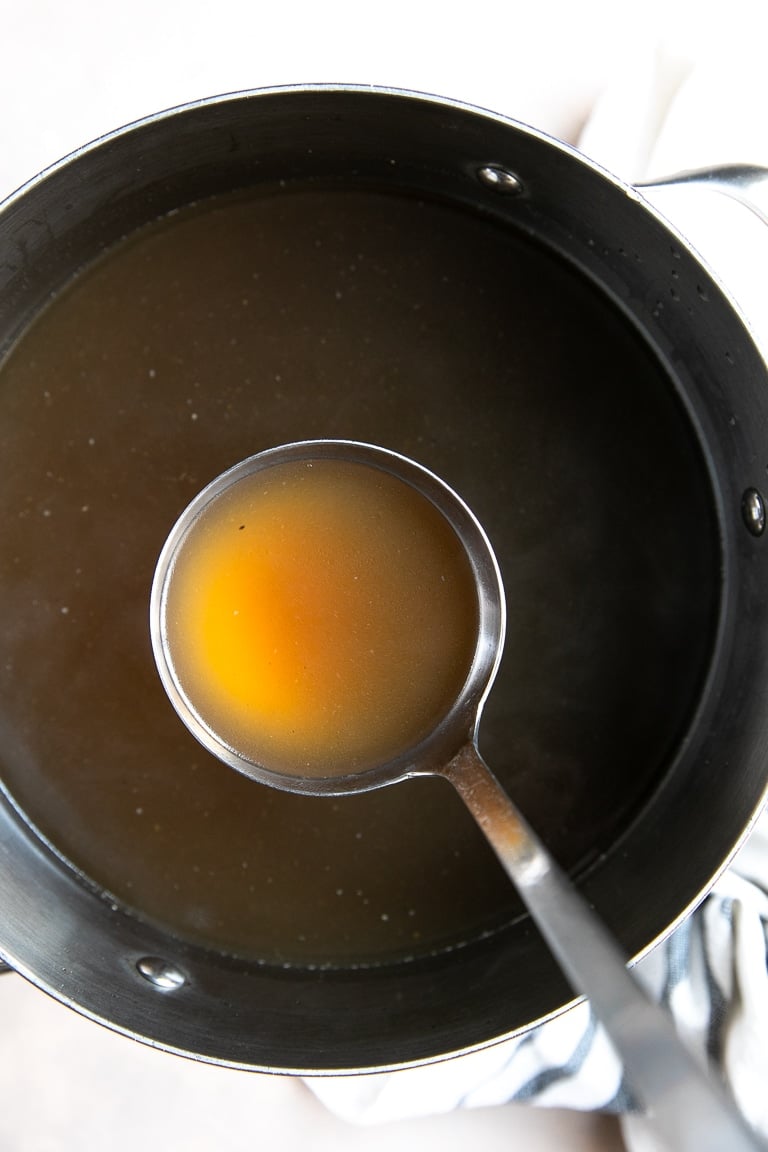
What is Bone Broth?
Bone Broth is a savory, nutrient-dense, and collagen-rich liquid made from simmering marrow-rich animal bones (beef, chicken, turkey, pork) in water for an extended period of time. In addition to bones and connective tissue, vegetables like celery, carrots, and onions, fresh herbs, and garlic for extra flavor.
Since bone broth is often graded by how gelatinous it is upon cooling, sometimes apple cider vinegar or white vinegar is added in small amounts to help break down the animal proteins and connective tissues. This aided breakdown helps provide a broth higher in protein and collagen.
How is Bone Broth Different From Regular Broth or Stock?
Technically there isn’t a clear hard line separating one from the other, but there are a few differences.
Totally confused? Let me try to clarify.
Bone broth: Beautiful, golden, and super-flavorful. Bone broth is made by simmering bones (specifically those high in collagen) for longer periods of time (often 12-hours on the stovetop) or pressure cooker for at least 3-4 hours. Once cooled, bone broth will usually firm-up into a jelly-like consistency due to its high gelatin content.
Regular Stock: Depending on the type of bones used, regular stock can be quite gelatinous after cooking. It typically simmered for longer periods of time compared to regular broth. Homemade chicken stock, as an example, can bee made using an entire, uncooked, whole chicken or just the remaining chicken carcass.
Regular Broth: Typically thinner as it contains much less, if any, collagen. Regular Broth is made from boiling actual meat, and less from marrow-rich bones. For example, after poaching chicken the resulting liquid is considered chicken broth.
So, if you’re wondering which of the three will give you the most collagen-rich and nutrient-dense broth, the winner is bone broth, hands down.
When prepared correctly, of course.
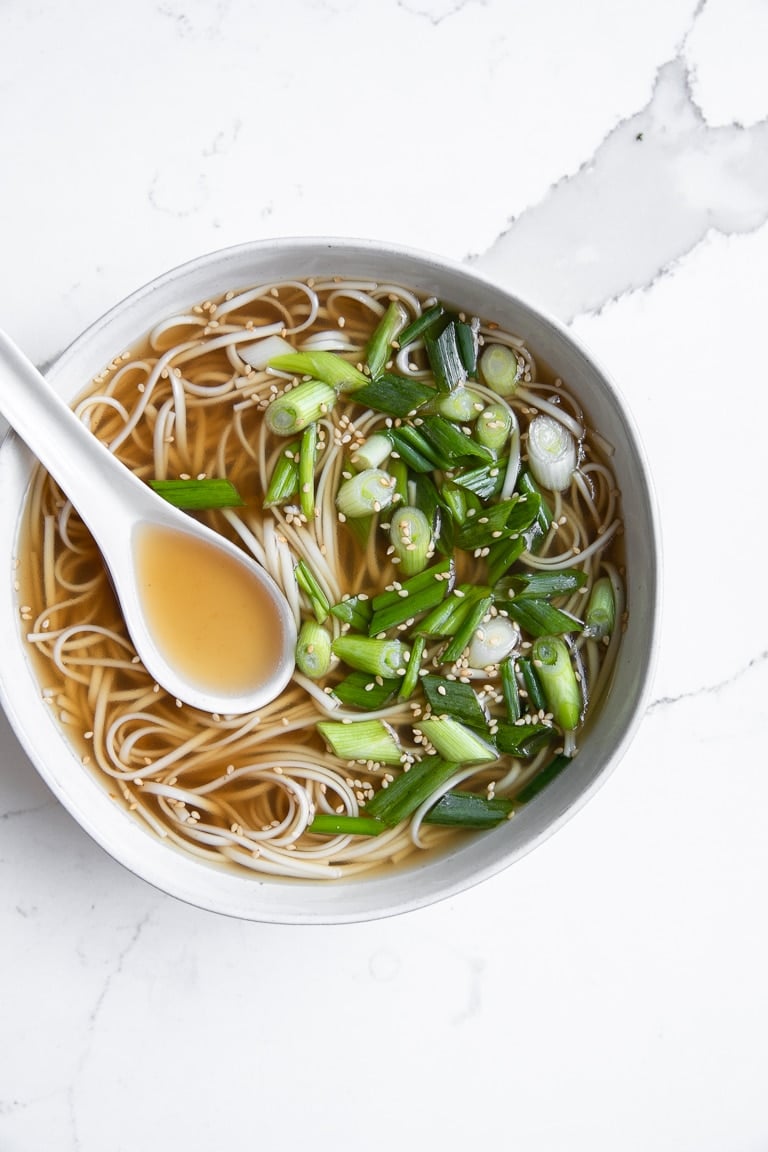
What are the Benefits of Bone Broth?
With its sudden rise in popularity, there has been a nonstop buzz all about the miracle health benefits of bone broth. We already know it to be a nutrient-rich liquid made by simmering animal bones (cow, chicken, pork bones, and sometimes fish bones) and connective tissue in water over a long period of time. But it is also believed that drinking bone broth is beneficial to our joints, digestive system, and skin as it contains many important minerals and nutrients.
While there is plenty of evidence to suggest these benefits to be true, there is no published research confirming, with absolute certainty that this is the case. Full disclosure.
6 (possible) benefits of drinking bone broth
- Bone broth is highly nutritious. As a total package, bone broth is rich with vitamins and nutrients such as calcium, magnesium, and phosphorous. The total amount will vary depending on the type of animal source and bones you use, but in general, you’ll find loads of calcium, magnesium, potassium, and phosphorus, Vitamin A, K2, and minerals like zinc, iron, boron, manganese, and selenium in any given batch of quality bone broth recipe.
- It may protect the joints. Tissues and bones contain collagen. When cooked, collagen turns into gelatin. This gelatin – liquid (when heated), thick and jelly-like (when chilled) – is filled with amino acids, the building blocks of proteins. Glucosamine and chondroitin, in particular, are thought to reduce the symptoms of osteoarthritis (source 1, 2) and reduce joint pain.
- It may aid in digestion. Especially for people with inflammatory bowel disease or leaky gut syndrome according to this article which explains that specific amino acids may decrease the duration of active disease and contribute to the maintenance of IBD remission.
- May lead to better night sleep. According to Neuropsychopharmacology, Glycine, a non-essential amino acid found in bone broth, like this Instant Pot bone broth recipe, may improve sleep quality. Of course, more research is needed.
- Claims that it may help you lose weight. Since bone broth is a rich source of protein some like to claim that it will help you feel fuller, longer, and therefore help you lose weight. I know that for me personally a cup of bone broth would never fill me up so I’m highly suspicious about this one.
- Suggested to help fight inflammation. The amino acids glycine and arginine have strong anti-inflammatory effects. Arginine, in particular, may help fight inflammation associated with obesity in women (source). Chronic inflammation may lead to a number of serious diseases such as heart disease, diabetes, metabolic syndrome, arthritis, and types of cancer.
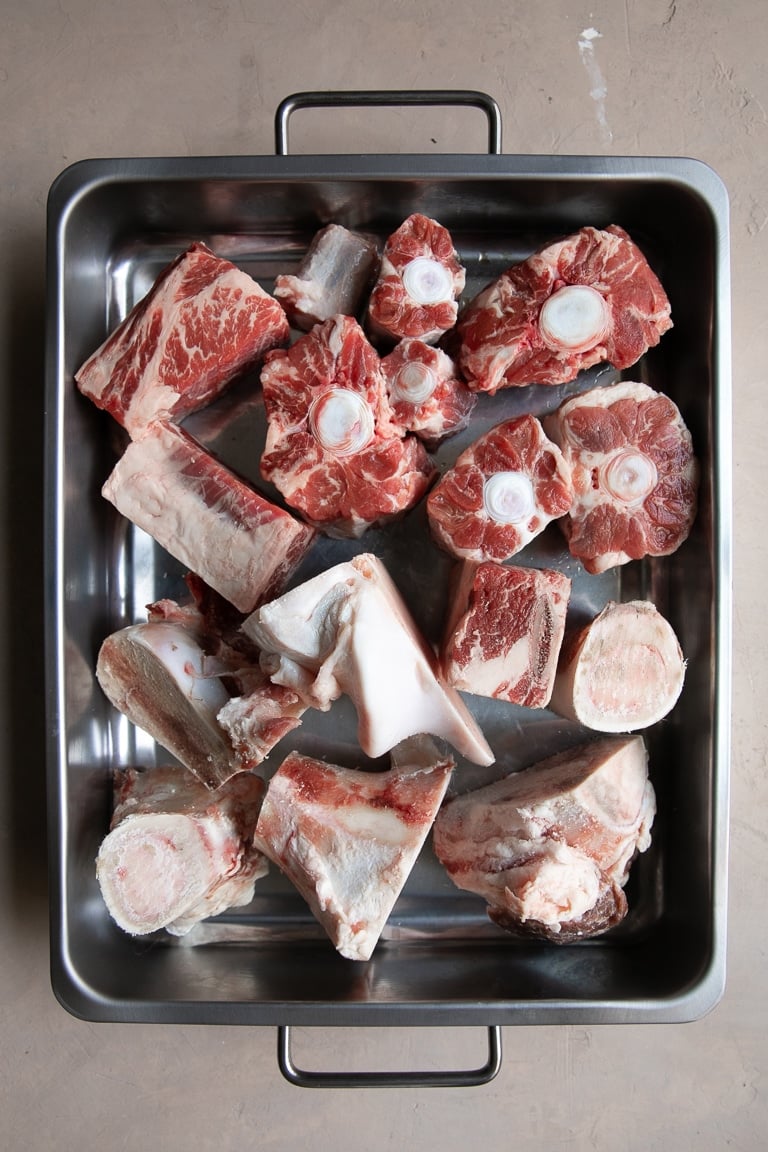
Ingredients in Homemade Bone Broth
- Beef bones
- Carrots
- Onions
- Celery
- Garlic
- Bay leaves
- Whole black peppercorns
- Whole star anise
- Cinnamon sticks
- Apple cider vinegar
If possible, try to purchase organic grass-fed beef bones. This guarantees a broth free of added hormones and antibiotics.
Equipment needed to make stock at home
You don’t need a ton of fancy equipment to make homemade broth. However, you will need a few essentials including,
- Stockpot– you will need at least two 8-quart stockpots to prepare this particular recipe.
- Roasting Pans or lined baking sheets – Because yes, for the best possible broth, you need to roast the bones before you boil them.
- Wire mesh strainer– inexpensive but completely necessary, you need a wire mesh strainer to strain the delicious broth from the bones and vegetables.
What are the Best Bones for Bone Broth?
In this particular beef bone broth recipe, I have added a mixture of knucklebones, short ribs, oxtail, and femur bones. The result was a delicious, nutrient-filled, gelatin-rich broth.
The best bones for the best bone broth (beef or chicken bone broth) include:
- Knuckles
- Joints
- Feet
- Marrow bones
- For added flavor incorporate meaty bones like oxtail, shank, and short ribs.
- Chicken feet (not included in this recipe) contain loads of gelatin and are less expensive than other gelatin-rich bones.
- The bones of younger animals contain a lot of cartilage, as it is this cartilage that will eventually turn to the bone as the animal ages. For this reason, veal bones are particularly prized for making stock (but I can’t do veal, so no veal bones in this soup).
Tip – If you’re unsure at all, ask the local butcher at your favorite grocery store for the best broth bones and then request that he or she cut them in half for you. Trust me, you do not want to bring home an entire femur – it won’t fit in your pot.
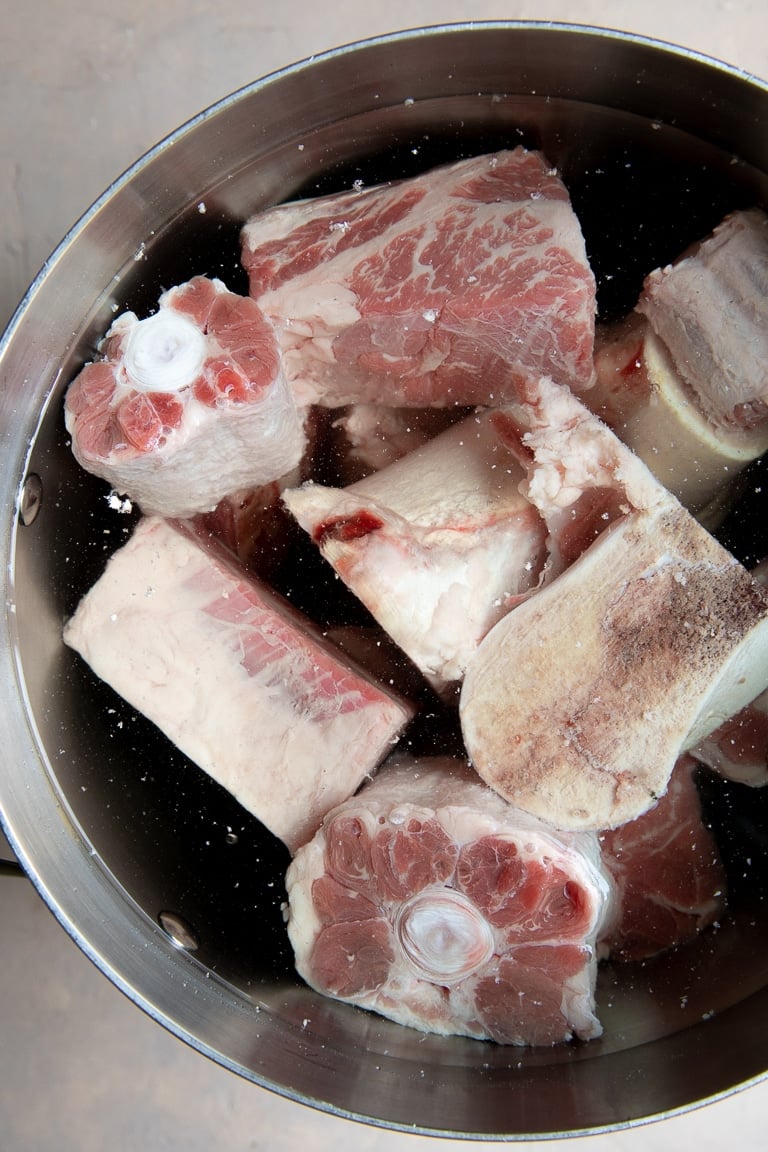
How to make bone broth
Although most major grocery stores carry bone broth, the cost of this convenience comes with a hefty price – around $5-6 a quart. Fortunately, making homemade broth at home is both easy and affordable.
Plan to start your broth in the morning, giving your bones at least 8-12 hours to simmer over low heat. If you prefer to make it using your Instant Pot or pressure cooker, check out my post dedicated just to that, How to Make Instant Pot Bone Broth.
Ok, let’s get started.
Step 1: Blanch the Bones
Divide the bones between two large pots and cover with cold water. Bring to a boil over high heat and simmer for 10-15 minutes before draining and rinsing the bones with water.
Do you have to blanch the bones? The answer is no. However, I recommend, especially if you’re making broth from beef bones, that you do blanch them first. If you’re using chicken bones or chicken feet blanching is less important, but beef bones really need this extra step, especially if you want a clear stock.
What’s the purpose of blanching? The purpose is to remove impurities, coagulated protein, and blood which ultimately results in a cleaner, better tasting broth.
As far as nutrient loss due to blanching? The nutrient loss is too small to justify not blanching (in my opinion).
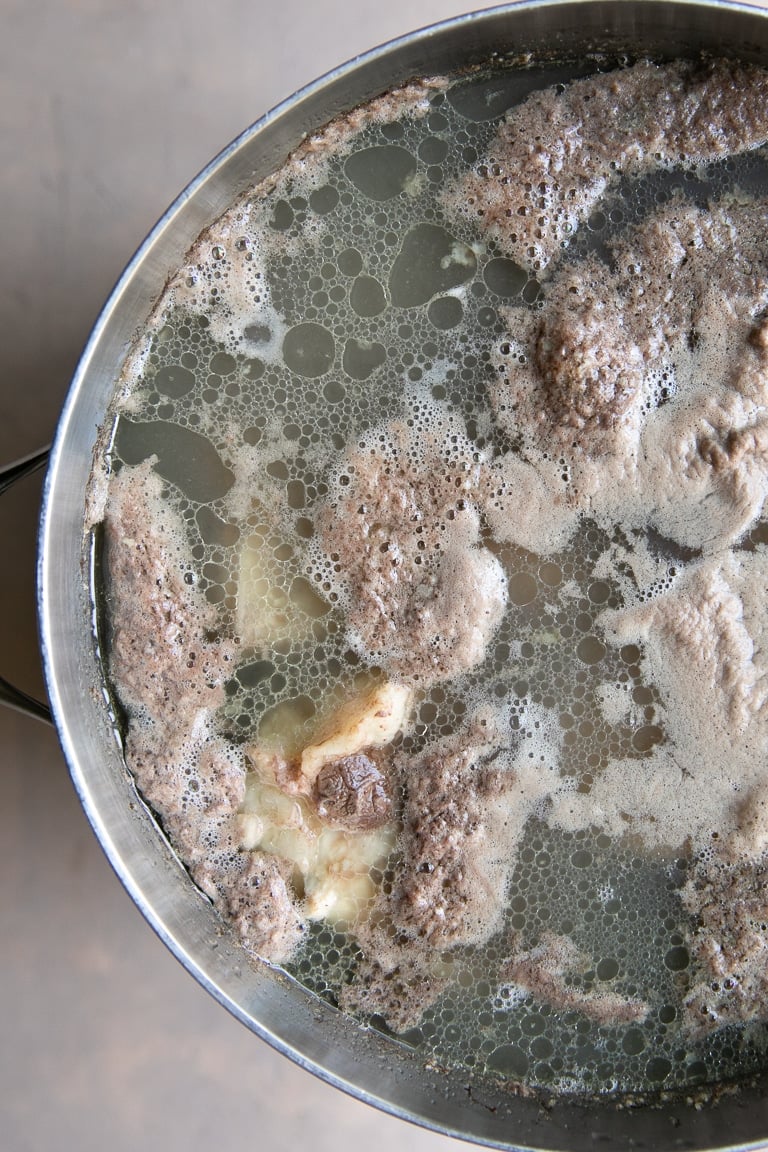
Step 2: Roast the Bones and Vegetables
Now that your bones have been blanched, drained, and rinsed, it’s time to preheat your oven to 450 degrees F. Transfer the bones and vegetables (carrots, onions, garlic, celery) to the roasting pans. Avoid piling them all on top of each other- use two roasting pans, if necessary. Roast for 30 minutes before gently tossing the bones and vegetables, and roasting for an additional 15-30 minutes more.
Why roast bones for broth? Roasting equals flavor! And we love a little added flavor, right? This step in an easy way to brown and caramelize your bones without a lot of added work. Do you want to char or burn your bones? No. But, nice, deep browning? Yes.
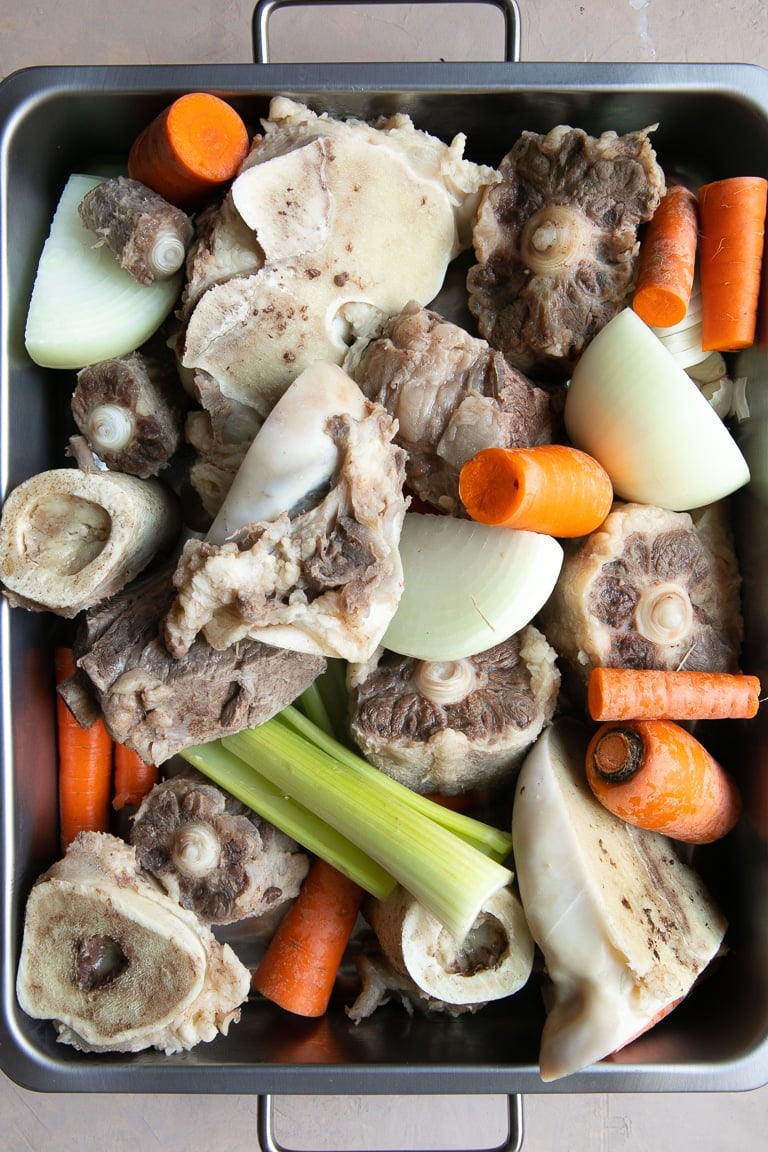
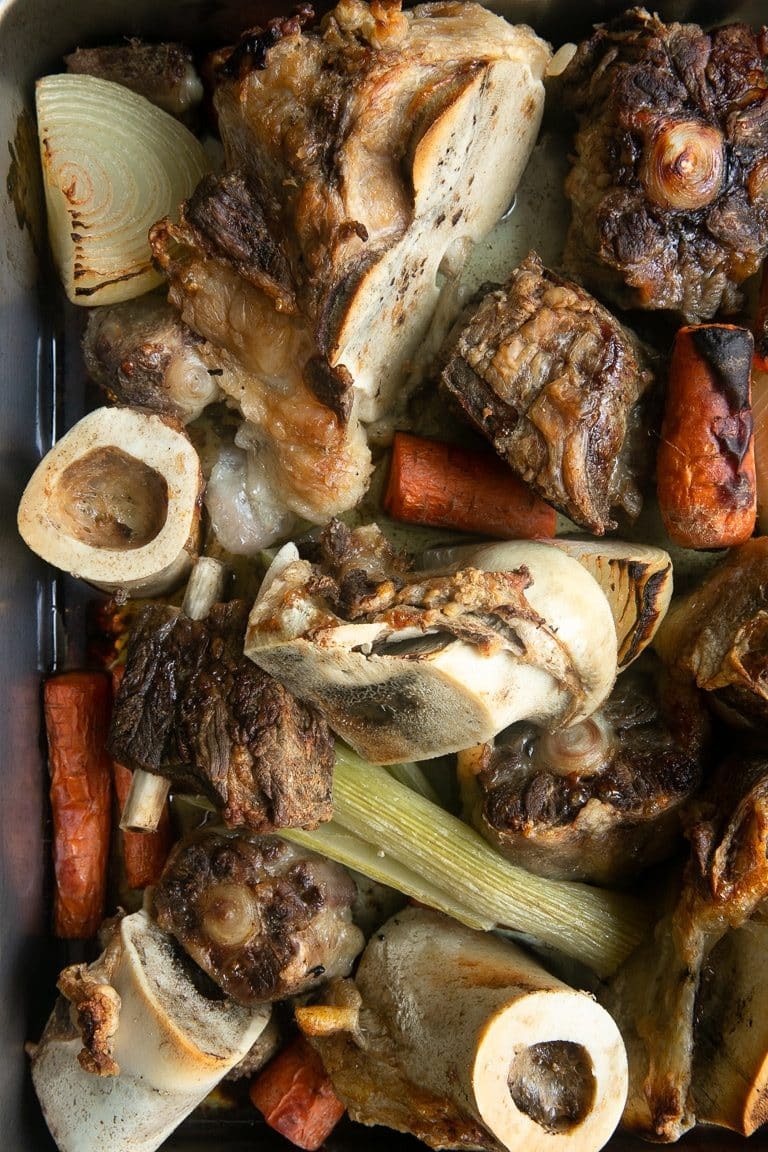
Step 3: Transfer the Bones Back to the Stockpots & Bring to a Boil
Wash the stockpots that were used to blanch the bones (this is super important) and divide the roasted bones and vegetables between the two pots. Scrape up any brown bits and juices remaining in the roasting pan using a metal spatula and a little water, if needed, and divide between the two pots (don’t worry, all those brown bits are FLAVOR!).
With the bones and vegetables divided, divide the bay leaves, peppercorns, star anise, cinnamon sticks, and apple cider vinegar between the two pots.
Fill each pot with approximately 12 cups of cold water, or enough water to cover the bones by approximately an inch.
Cover each pot with a tight-fitting lid and bring to a low boil.
Can you cook your broth in a slow cooker (Crockpot)?
Yes. Absolutely. For this recipe, you will likely need 2 large slow cookers. Instead of transferring the roasted bones, veggies, herbs, and spices to large stockpots divide them among two (or three) slow cookers, cover with cold water, and cook on low for 24-48 hours with the lid slightly ajar. Add additional water, as needed, to keep the bones covered.
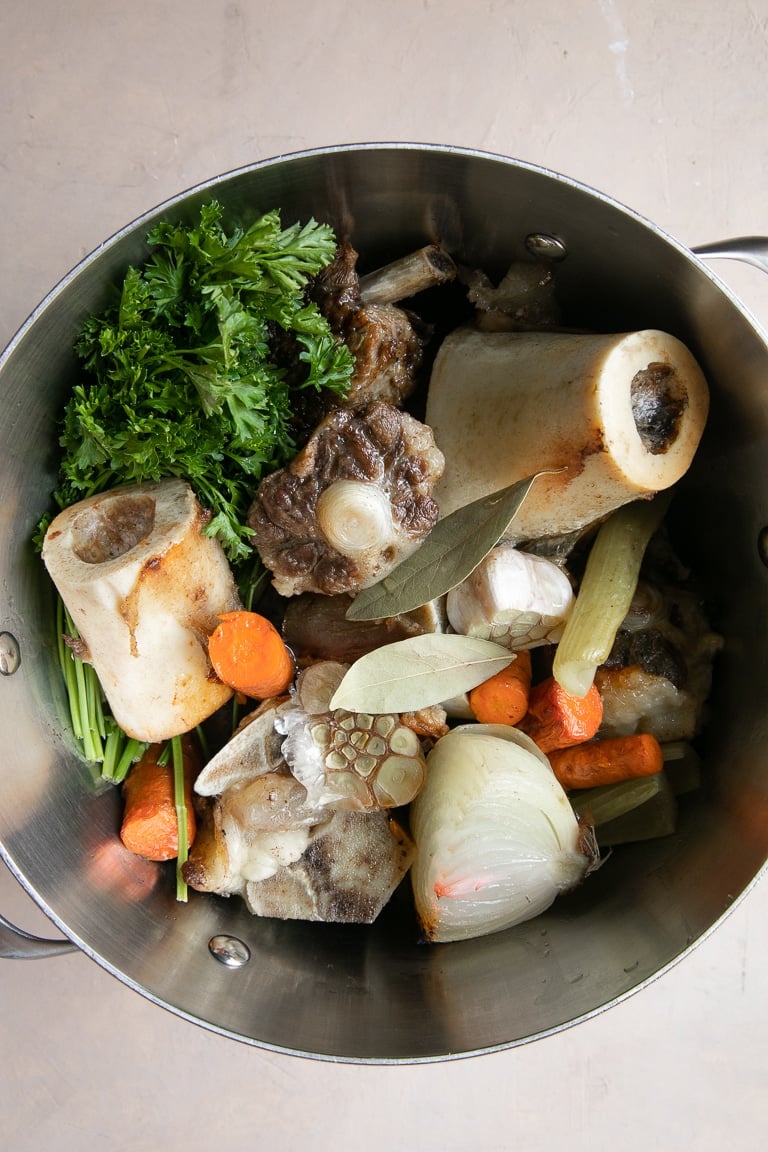
Step 4: Simmer
Reduce heat to low and simmer, with the lid slightly ajar, skimming any foam or excess fat, as needed. Simmer for at least 8-12 hours or up to 24 hours (do not leave the stove running overnight. Simply cool and store in the refrigerator and continue to simmer the next day). Add more water if needed to make sure bones and vegetables remain fully submerged.
- If the vegetables (particularly the carrots) turn too soft and mushy at any point throughout cooking, use a slotted spoon to remove. Enjoy as a delicious snack or discard.
Step 5: Strain the Bones
Once the bones have simmered and your broth is ready, you will need to strain the broth through a fine-mesh strainer. For an extra clear broth, strain a second time through a food-grade cheesecloth.
Set aside the broth to cool and allow the bones to cool (see more on storage and cooling below).
Step 6: Don’t Forget About the Meat
Depending on the type of bones you use to make your bone broth, you may or may not have any meat left to be picked off. In my case, I had tons of leftover delicious meat perfect for soup, sandwiches, or (if you’re not into the meaty bits) the family pet. Don’t let it go to waste! As for the vegetables, blend them together and add them to cooked rice, mashed potatoes, or, add a little broth and make it a delicious blended soup.
Step 7: Skim the Fat from Your Broth (optional)
Add a couple of handfuls of ice to your broth to expedite cooling and cover with a lid. Transfer your broth to the refrigerator and allow it to cool completely. The result will be a hard, thick layer of fat and a bottom layer that is your bone broth (which should look like gelatinous brown jello). If desired use a fork to scoop off the top layer of fat. This will leave behind the healthy bone broth, minus the fat.
Step 8: Store your bone broth
Bone broth stores well in the refrigerator for approximately 5 days. If you make a large batch, I recommend freezing smaller batches in the freezer for up to 6 months (it reheats perfectly!)
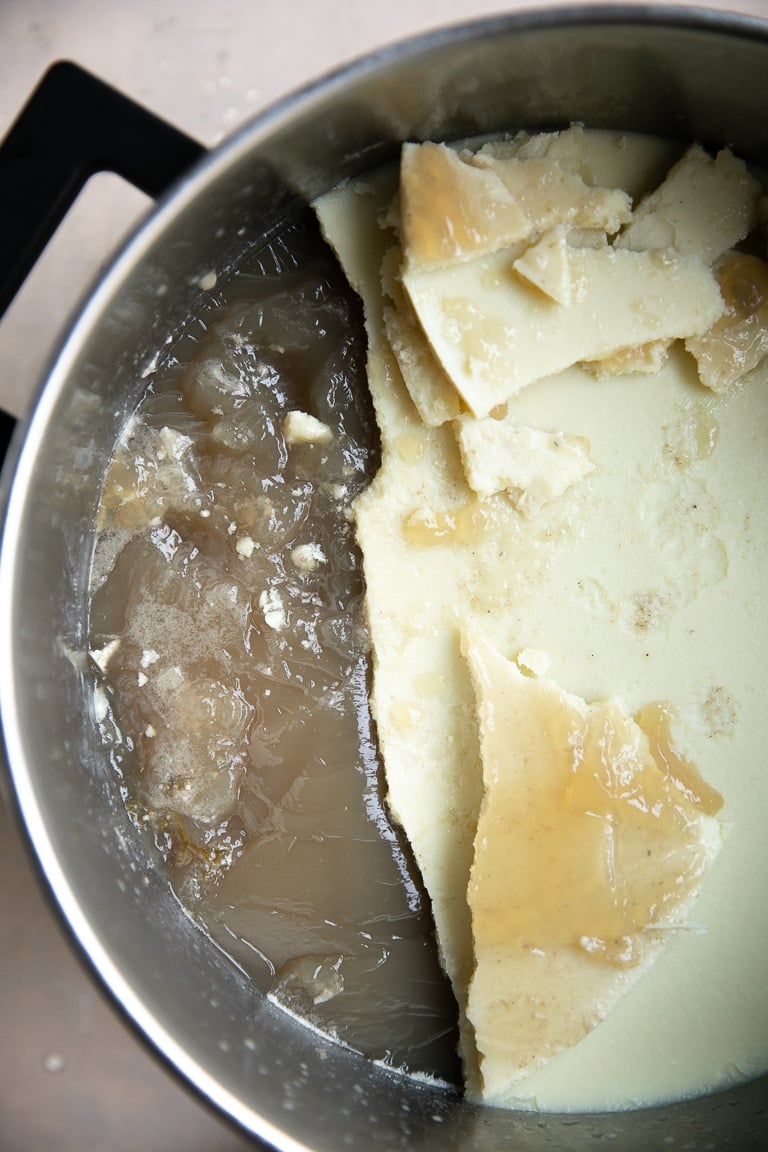
Tips and Tricks
- Use a mixture of different beef bones. Not all bones are created equal, as such, try to use 2-3 different types of bones to make your broth.
- Don’t forget to blanch the beef bones before roasting. Guys, this step is SO IMPORTANT. Blanching the bones for 15-20 minutes helps remove all those nasty bits that, well, make your bone broth look and taste kinda gross. These nasty parts won’t hurt you, but in order to achieve the beautiful, clear, rich bone stock, you need to blanch the bones.
- Roast your bones. Roast them high and roast them long. Roasting the beef bones browns and caramelizes them. This translates to more flavor. Who doesn’t want more flavor?
- Avoid the temptation to add too much “other stuff”. You are making bone broth NOT bone/vegetable/herb garden broth. This is not to say that you shouldn’t add any roasted veggies or spices, but keep it at a minimum so that the beef bones can really shine.
- If one stockpot isn’t big enough, use two. Your beef bones want to be fully submerged in water. If your pot isn’t big enough, use two.
- Allow enough time for the bones to simmer. You guys, a few hours is not enough time. I allowed this pot of beef bones to simmer for 14 hours and it turned out just perfect. Patience is key. With that said, longer is not always better. There is no need to simmer your bones for any longer than 24 hours.
- Refrigerate the soup overnight and remove the fat layer from the top. Of course, you don’t have to do this. Or you can do this and leave some of the fat. No matter what you decide, once the broth is reheated, it will all dissolve back into the smooth, beautiful delicious broth you started with.
- Add salt to taste. If you’re expecting your bone broth to taste identical to your favorite Vietnamese bowl of Pho without adding any salt then I am sorry to say you will be very disappointed. You will need salt. Exactly how much depends entirely on you.
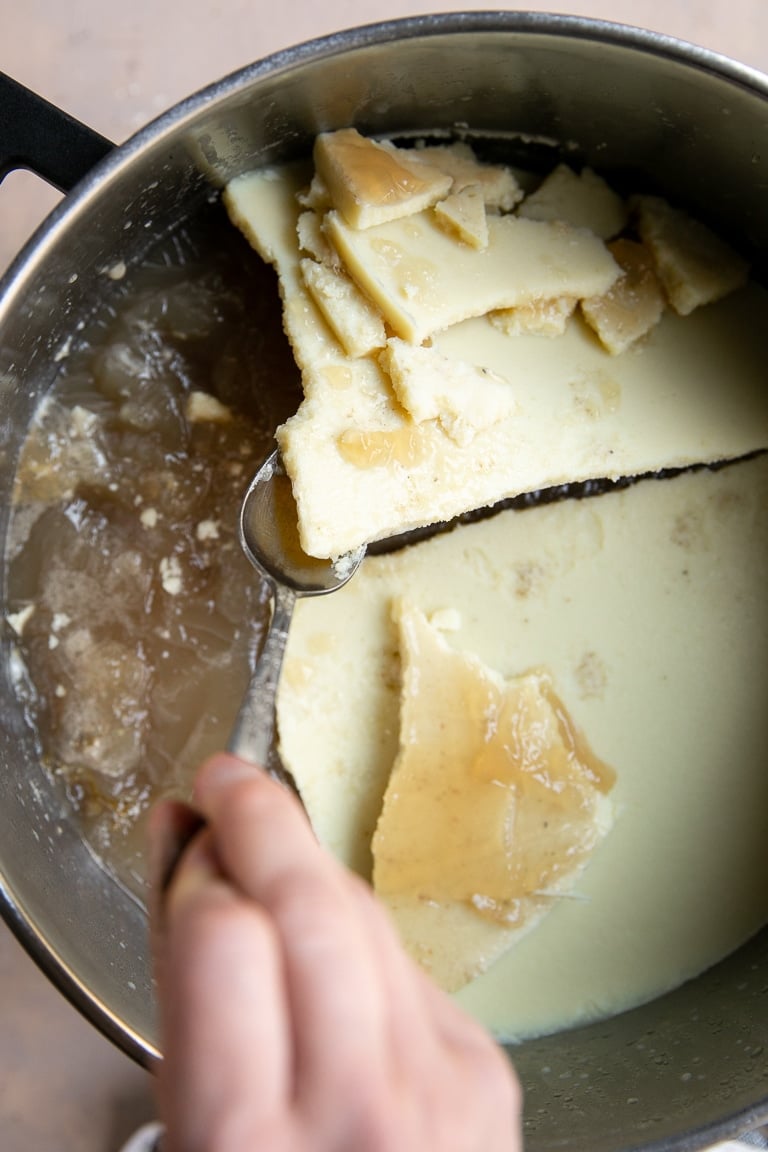
How to Store Bone Broth
Let’s discuss storage and freezing.
I like to store my broth in sealed jars or freezer-safe bags ziplock bags. These are my favorite glass storage jars to use when freezing. They’re tall and skinny and great for deep freezers. When storing in the refrigerator, however, I usually keep leftovers in a pot with a lid as it is so much easier to reheat.
How long will leftover bone broth last?
Broth stored in the refrigerator will keep for 4-6 days while broth stored in the freezer will keep for at least 4-6 months.
Before storing or freezing always…
Before storing it’s super important to cool your broth to room temperature. Ideally, you want to do this as quickly as possible to prevent any chance of contamination. The easiest way to do this is by adding a couple of handfuls of ice to the pot, covering, and waiting for the broth to cool. The ice will help expedite this process.
Or, as suggested by a reader, fill your sink or bathtub with a few inches of cold water. Place the pot in the cold water and allow the broth to cool to room temperature.
How to Use All That Broth
Your reasons for making bone broth will likely determine how you serve it. For restorative and medicinal purposes, it is hugely popular to sip a cup of warm bone broth with a sprinkle of sea salt and cracked pepper.
If you’re not really interested in drinking your broth, use it the same way you would regular meat stocks or broths.
- Use it to make soups and stews, including bok choy soup, Vietnamese pho recipe, chicken and wild rice soup, and beef stew.
- Use it to cook rice and grains like brown rice, risotto, wild rice, farro, lentils, and quinoa. Swapping water for bone broth is an easy way to add extra flavor and protein.
- Use it to make delicious sauces like gravy, roux, pan sauces, or reductions.
- Other delicious recipes include jambalaya, beef stroganoff, and tater tot casserole.
How Much Bone Broth Can I Drink Each Day?
A lot of you have asked how much broth you can (or should) drink each day. The truth is that I am not a doctor. So, if you’re drinking bone broth for medicinal reasons at all, I highly recommend consulting your doctor.
For anyone looking to include bone broth as part of an already balanced and healthy diet and lifestyle, enjoy anywhere from 2-4 cups daily.
Bone broth is not suitable for vegetarians, vegans, or anyone following a low-protein diet. It is wonderful, however, for those looking to include more protein as it is paleo and keto-approved, gluten-free, and dairy-free.

More Easy Recipes,
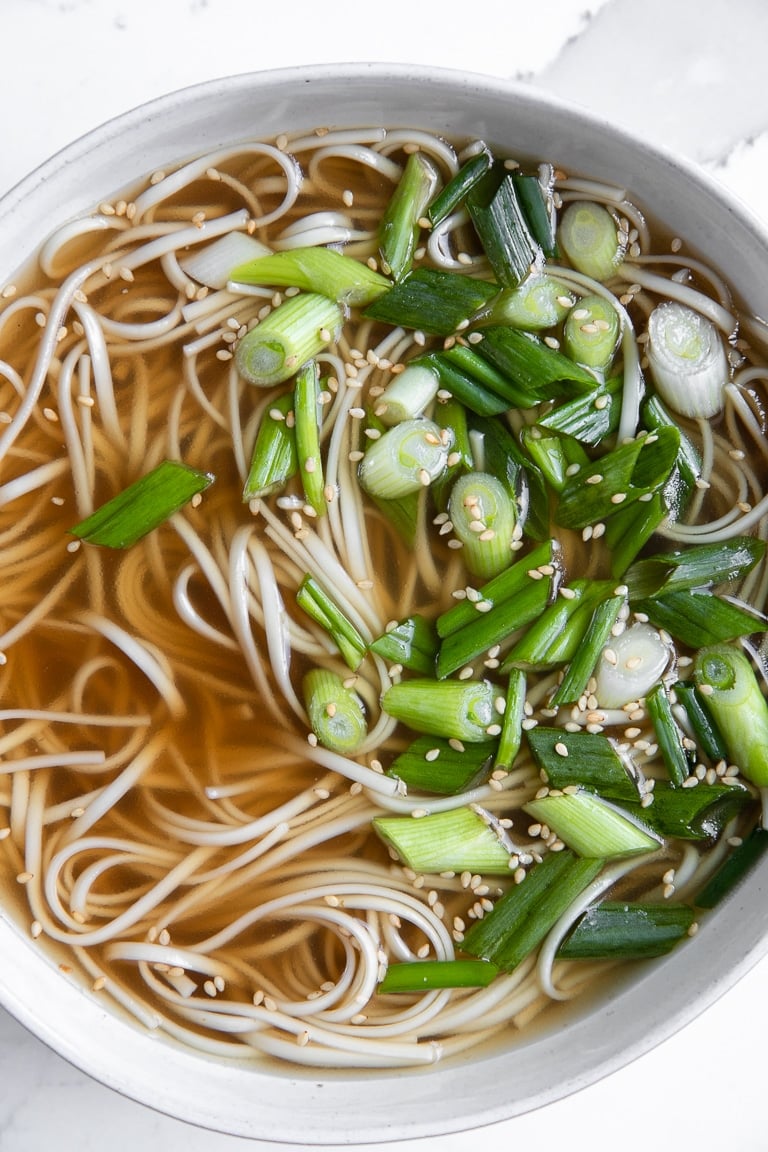
If you try making this Homemade Bone Broth Recipe, please leave me a comment and let me know! I always love to hear your thoughts.
Join the Club
Unlock unlimited, ad-free browsing of 1,200+ recipes, plus meal plans, easy grocery lists, exclusive recipes, and more.
Cancel anytime during your trial - no risk, no hassle.
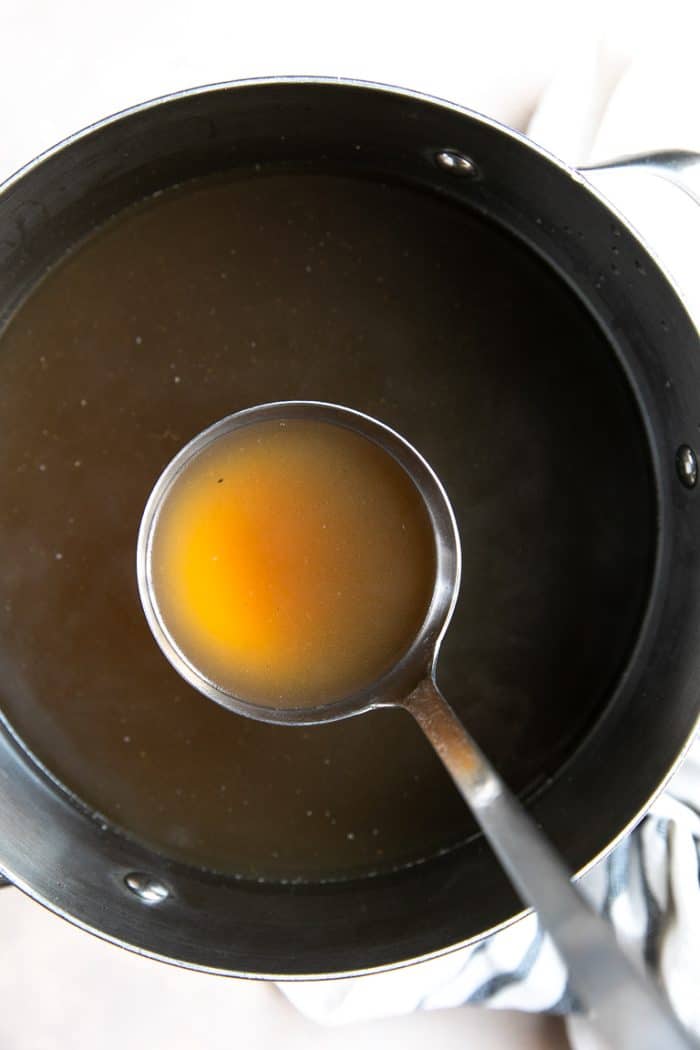
Bone Broth Recipe (How to Make Bone Broth)
Ingredients
- 10 pounds beef bones, preferably a mix of marrow bones (femur bones) and bones with meat on them (oxtail, short ribs, and knucklebones cut in half)*
- 4 large carrots, chopped into 2-inch pieces
- 2 medium onions, quartered
- 2 whole heads garlic, halved crosswise
- 6 stalks celery, cut into 2-inch pieces
- 4 bay leaves
- ¼ cup black peppercorns
- 4 whole star anise, optional
- 2 whole cinnamon sticks, optional
- 2 tablespoon apple cider vinegar
Instructions
- Blanch the bones. Divide the bones between two large stockpots and cover with cold water. Bring to a boil over high heat and simmer for 15-20 minutes before draining and rinsing the bones with water.
- Roast the bones and the vegetables. Ok, so the bones have been blanched. Now, preheat the oven to 450 degrees F. Transfer the bones and vegetables (carrots, onions, garlic, celery) to the roasting pans. Don't pile them all on top of each other- use two roasting pans. Roast for 30 minutes before gently tossing the bones and vegetables, and roasting for an additional 15-30 minutes more.
- Transfer the bones and vegetables back to the stockpots. But not before washing the stockpots first. Make sure you wash your pots after the bones were blanched and drained. Transfer the bones and vegetables back to the stock pots and scrape up any remaining bits and juices remaining in the roasting pan using a metal spatula and a little water, if needed. Transfer to the pot with the bones (don't worry, all those brown bits are FLAVOR!).
- Boil the bones. With the bones and vegetables divided between the two pots divide the bay leaves, peppercorns, star anise, cinnamon sticks, and apple cider vinegar between the two pots. Fill each pot with approximately 12 cups water, or until bones are fully submerged. Cover the pots and bring to a low and gently boil.
- Simmer the bones. Reduce heat to low and simmer, with the lid slightly ajar, skimming any foam or excess fat, occasionally. Simmer for at least 8-12 hours, ideally 24 hours (do not leave the stove running overnight. Simply cool and store in the refrigerator and continue to simmer the next day). Add more water if needed to make sure bones and vegetables remain fully submerged.
- Strain the bones. Once the bones have simmered and your broth is ready, you will need to strain the broth through a fine mesh strainer. Set aside the broth to cool and allow the bones to cool.
- Don't forget about the meat. Whether you eat the meat still left on the bones in a bowl of soup or in sandwiches, I can almost guarantee that there is a TON of delicious meat waiting to be picked from the bones. Don't let it go to waste! Discard the meat-free bones and vegetables.
- Skim the fat from your broth (optional). Add a couple handfuls of ice to your beef broth to expedite cooling and cover with a lid. Transfer broth to the refrigerator and allow broth to cool fully. The result will be a hard, thick layer of fat and a bottom layer that is your bone broth (which should look like gelatinous brown jello). If desired use a fork to scoop off the top layer of fat. This will leave behind the healthy bone broth, minus the fat.
- Store your bone broth. Bone broth stores well in the refrigerator for approximately 5 days. If you make a large batch, I recommend freezing smaller batches in the freezer for up to 6 months (it reheats perfectly!).
Notes
- Yes. Absolutely. For this recipe, you will likely need 2 large slow cookers. Instead of transferring the roasted bones, veggies, herbs, and spices to large stockpots divide them among two (or three) slow cookers, cover with cold water, and cook on low for 24-48 hours with the lid slightly ajar. Add additional water, as needed, to keep the bones covered.
Nutrition
Nutrition information is automatically calculated, so should only be used as an approximation.
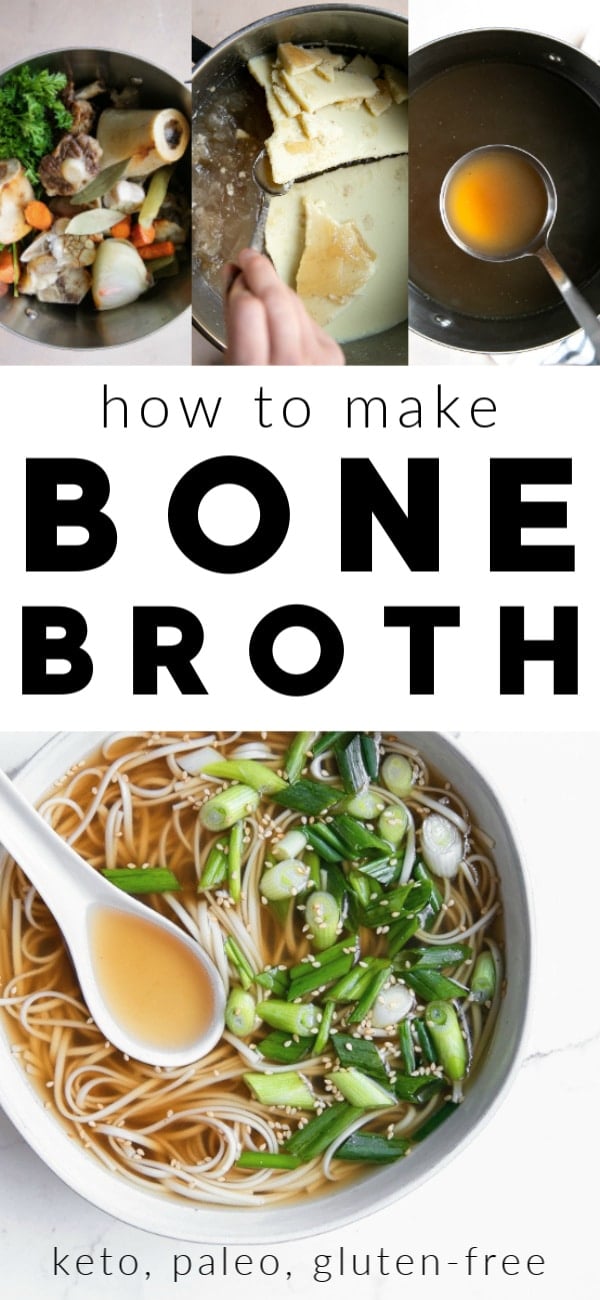

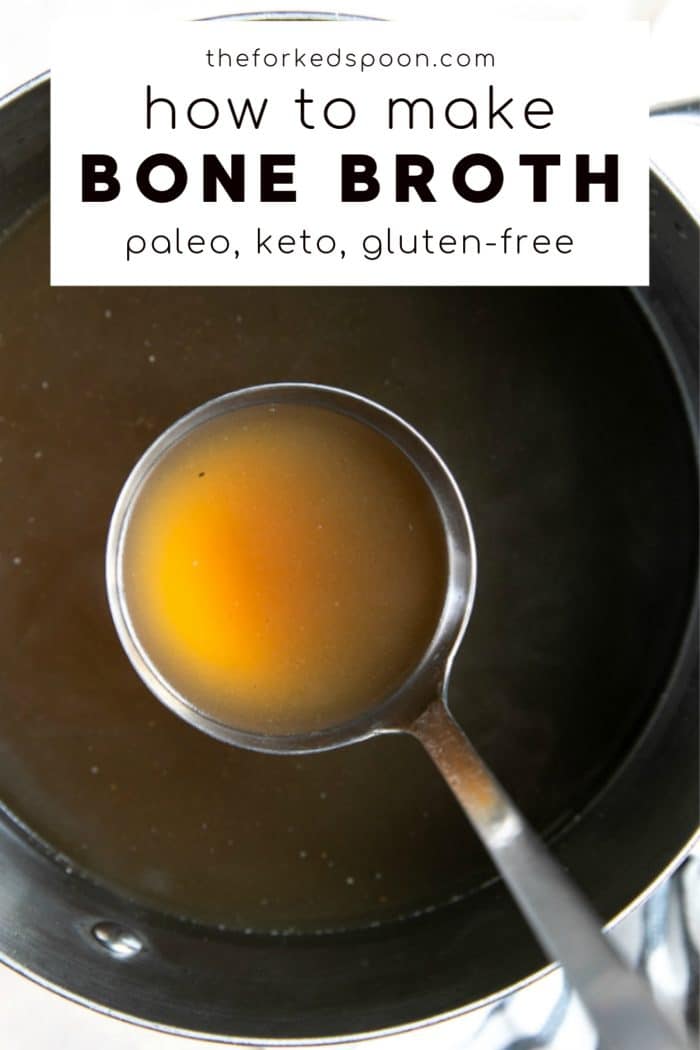

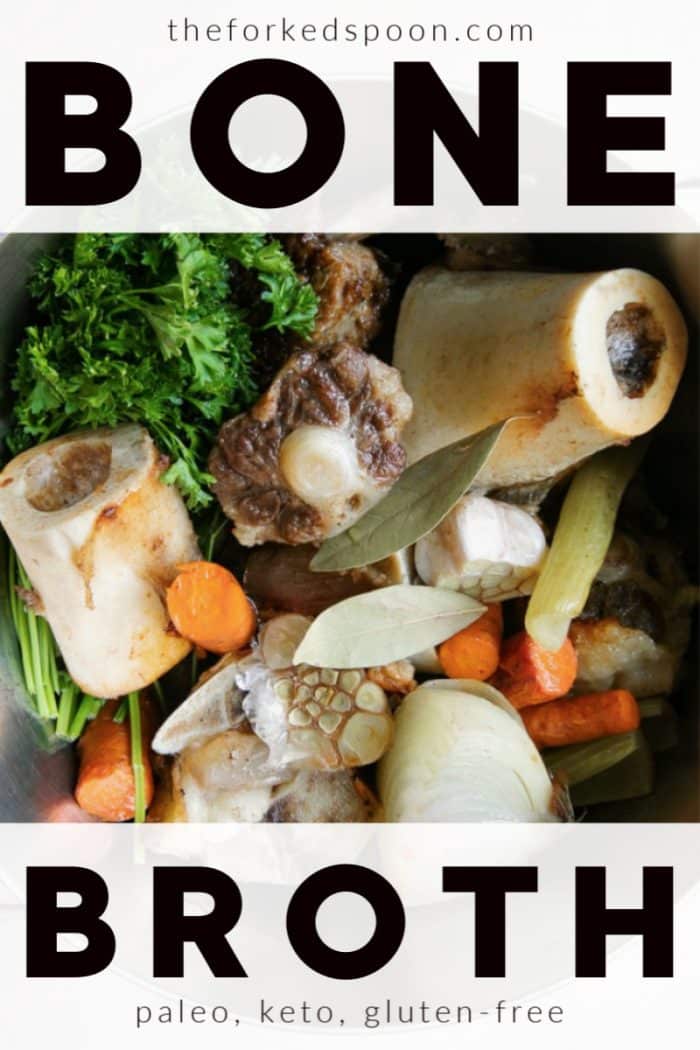
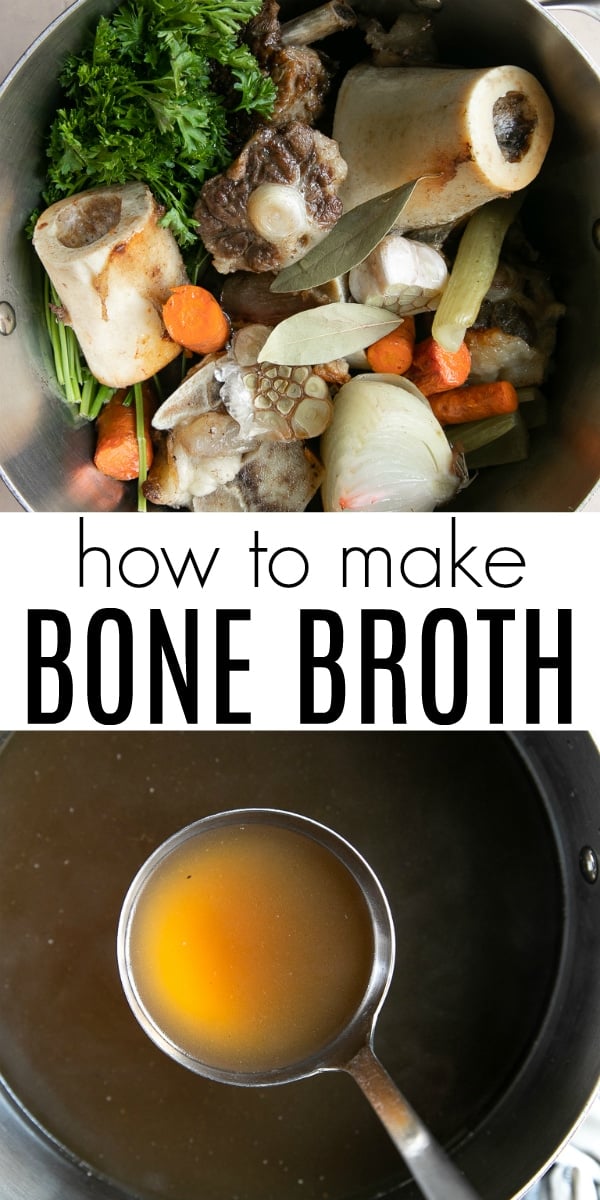


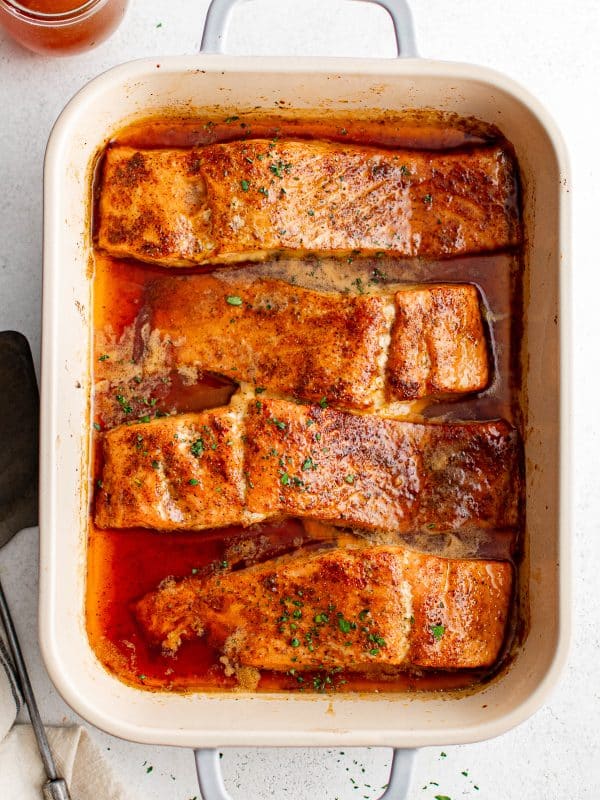
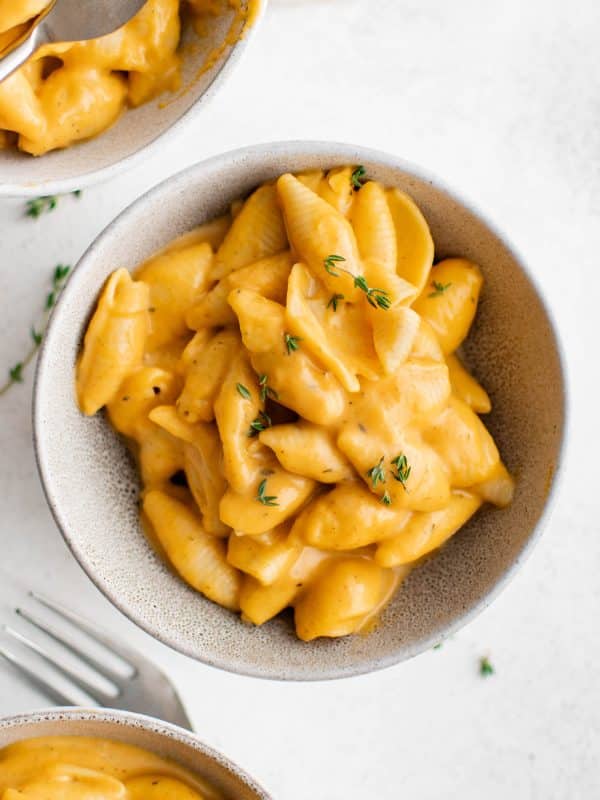









Hi – I’m wondering what the serving size is in regards to the nutritional information. Is 1 cup 45cal?
Great question! Due to evaporation during simmering, the exact serving size can vary slightly, but generally, the nutritional information provided is based on approximately 1/24 of the finished broth. If you simmered your broth longer or had significant evaporation, your broth might be slightly more concentrated and thus have slightly higher nutritional values per serving. I recommend adding a little extra water at the end if needed to reach your desired serving size. Hope this helps!
Hei Chef Jessica, thank you, very helpful. My bones are boiling as I type. Quick question, why leave the lids of the pots partially open (couple of centimeters or an inch)? Thinking to save on energy and keep them fully closed. Hope to learn more 🙂
Hi there! I’m glad to hear the recipe is coming in handy! Leaving the lid slightly ajar when simmering bone broth helps to prevent the liquid from getting too hot and boiling vigorously, which can make the broth cloudy instead of clear. A gentle simmer is what you’re aiming for, as it allows the flavors and nutrients to slowly extract from the bones while maintaining clarity. Keeping the pot fully covered can sometimes lead to a rolling boil, which might disturb the sediments in the broth, affecting its final appearance and texture. Thanks for your question, and I hope your bone broth turns out wonderfully! 😊
I made bone broth for the first time using your recipe- it wasn’t in my budget to get 10lbs worth of bones, but I was able to get about 6.5lbs and adjusted some of the veggie quantities (1 less celery stalk, smaller onions instead of medium, smaller carrots instead of large) but kept the other aromatics the same (garlic, peppercorn, cinnamon, star anise, Bay leaf). I followed your steps exactly. The result was a very flavorful, clear, golden brown broth. After refrigerating, it is definitely gelatinous, but not so solid like set jello (which is what I was hoping for, so that I could give my toddler cubes to eat)… any suggestions as to how to get a more gelatinous broth?
I’m also wondering if you have any advice on turning this broth into more of a typical pho tasting broth?
Thank you! I think your recipe is great!
I’m glad to hear that you tried making bone broth and found the recipe helpful! For a more gelatinous broth, increasing the proportion of bones that contain collagen, such as knuckles, feet, or marrow bones, can help. Since you used 6.5 lbs of bones, adding a few more pounds of these types of bones can boost the gelatin content. Slowly simmering the broth for a longer period can also extract more gelatin from the bones.
To transform your broth into a pho-flavored one, consider adjusting the spices slightly. Add more star anise, a couple of cloves, a small piece of ginger, and perhaps a bit more cinnamon. These spices are key to achieving that distinctive pho flavor. You might also want to experiment with adding a bit of fish sauce for depth and a touch of sugar for balance.
Thank you for your kind words about the recipe, and I’m excited to hear how your next batch turns out!
Thank you so much for your reply, that is very helpful! I simmered the broth for 12hrs, but will use more of the mentioned bones and simmer for longer next time.
Would heating my current batch (maybe 1L worth) and adding those mentioned spices be okay? Any other tips for how long to simmer it for with the add -ins? Thank you again, I really appreciate your guidance!
You’re very welcome, Tania! Yes, heating your current batch and adding those spices is a great idea to infuse it with pho flavors. For the spices, add them to the broth and simmer for an additional 30 to 45 minutes. This should be enough time for the flavors to meld without overpowering the broth.
If you’re reheating about 1 liter, start with a small piece of ginger (about an inch), one or two star anise, a couple of cloves, and a small stick of cinnamon. Taste it as it simmers and adjust the spices as needed. Adding a splash of fish sauce towards the end of simmering will also help achieve that authentic pho taste. Just remember to add these flavorings gradually—you can always add more, but it’s hard to take them out once they’re in!
I hope this helps, and I look forward to hearing how your enhanced broth turns out!
Thank you again for your tips and guidance. I tried what you mentioned and was able to produce a pretty good pho broth! You were right about starting slow, it made all the difference. I did add some brown sugar to adjust the taste to my preference, and it turned out very close to what I was hoping for! I will follow your pho recipe from the start next time and see how that turns out!
I’m thrilled to hear that the tips helped you craft a delicious bone broth! I look forward to hearing how my full pho recipe turns out for you next time — happy cooking!
What is the quantity of vegetable and spices. A cup or two?
Please see the recipe card directly above for the full list of ingredients, but here are the veggies:
4 large carrots – chopped into 2-inch pieces
2 medium onions – quartered
2 whole heads garlic – halved crosswise
6 stalks celery – cut into 2-inch pieces
this was SOOOO good! I have never made beef broth before, but that is changing now!
I am glad your first time turned out sooo good 🙂
I’m making this for my sick children and my pregnant self! My question is , does anyone have tips/ alternatives as to how to freeze this in something other than plastic ? I’m thinking I may have to do it but I didn’t want to make something healthy and then have it leeching 😫.
Also, when you pull it from the freezer to reheat, do you just warm it back up and drink it ? I’m trying to understand that this isn’t soup base as in vegetable soup right ? ( I did read the part in your article on the different types of broth, stock etc ) I’m just still unclear how to reheat and use .
I’m so glad you’re finding the bone broth recipe useful, especially during such a crucial time for you and your family’s health! For freezing the broth without using plastic, you can use glass jars or containers. Make sure to leave some room at the top of each jar for the liquid to expand as it freezes, to prevent the jars from cracking. Glass is a fantastic alternative because it doesn’t leach chemicals and keeps your broth as healthy as you intended.
When you’re ready to use the broth, simply thaw it in the refrigerator overnight, or for quicker thawing, you can submerge the sealed container in cold water. Once thawed, the broth can be reheated on the stove until hot, which is perfect for sipping directly. Bone broth isn’t just a soup base; it’s also excellent for drinking on its own, especially for its nutritional benefits. It’s rich in minerals and a great source of collagen, which can be very soothing and nourishing, particularly when you or your family aren’t feeling well.
Remember, while it can be used as a flavorful and nutritious base for soups and stews, bone broth on its own has many health benefits and is perfect for a quick warm drink. Just heat it until it’s steaming hot and enjoy!
Can I blanch the bones while frozen or should I let them defrost before I start?
Blanching from frozen is fine 🙂
Going to make this for my baby. I’m confused so if I get 10 lbs of bones (going to do chicken and beef in that ok?) how much water to I need? I have a big la cruset stock pot. Is that big enough for the whole recipe. Really don’t want to go get another lol. It’s 11.4 L. I’ll ask my butcher for the bones. For the short ribs bones is that going to be just like regular short ribs that I would get to cook or are there ones that are less meaty???
It sounds like you’re gearing up to make a great batch of bone broth! Mixing chicken and beef bones is perfectly fine and will give you a rich, flavorful broth. Regarding the water amount, a good rule of thumb is to cover the bones by about 2 inches with water. So, for 10 lbs of bones, you’ll want enough water to fully submerge the bones plus a couple of inches.
Your 11.4-liter (which is about 12 quarts) Le Creuset stock pot might be just right for 10 lbs of bones, as long as they can all fit comfortably beneath the water level. If it seems too tight, you might not need to use all the bones at once, or you could consider making two batches.
As for the short rib bones, you can indeed ask your butcher for bones that are less meaty if you prefer. Regular short ribs will also work fine; they’ll add some extra flavor from the meat still on the bones, which is great for making broth. Just make sure to brown them well if you’re using meaty ones, as this will add depth to your broth’s flavor.
I hope this helps! Enjoy your broth-making adventure.
I made this broth last year and it came out wonderfully. It really was like jelly! Trying my hand at it again but want to take an adjustment. Is it ok to put the bones in a mesh bag or will that be an issue?
I’m glad to hear your broth turned out great last time! Using a mesh bag for the bones can actually be a handy technique, especially when it comes time to strain the broth. It makes it much easier to remove the bones without having to fish them out individually. However, make sure the mesh is not too fine; you want to allow plenty of water circulation so the nutrients and flavors can leach out of the bones effectively. As long as your mesh bag is large enough to give the bones some room to be surrounded by water, and the water can flow through it easily, you shouldn’t encounter any issues. Go ahead with your adjustment, and happy broth-making!
I am going to make this broth today.
You mentioned adding salt for flavour.
How much salt would you add to each pot.
Thanks
I would salt it at the end to taste 🙂